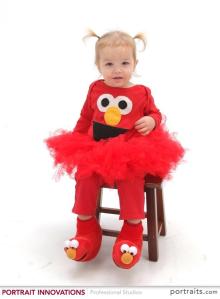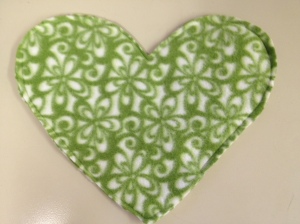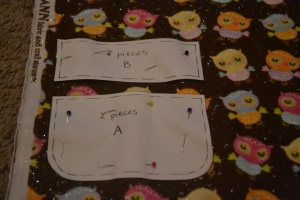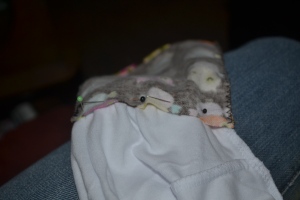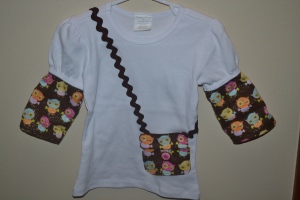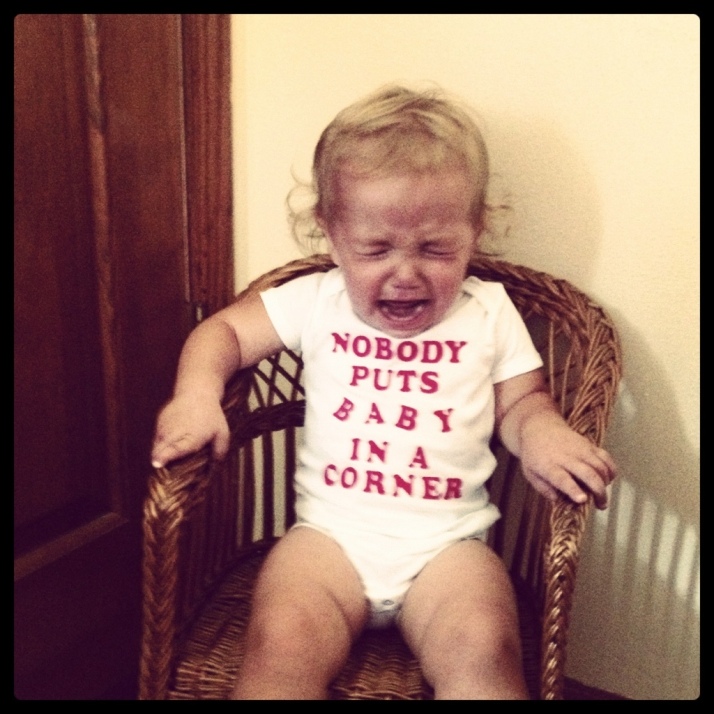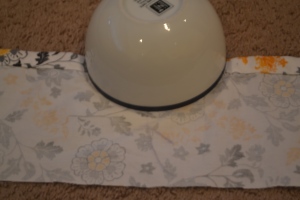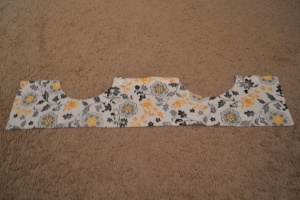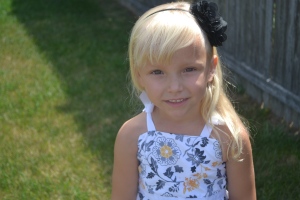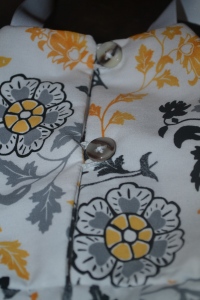I’m VERY excited to bring a new series of posts called “3 yards, 3 outfits” involving some awesome fabric that I found at JoAnn Fabrics. This whole idea started when I was browsing through the store, trying to find an adult patterned fabric to make myself an outfit. I don’t often buy myself clothes. I overly obsess about my children’s wardrobe and all the cute things they get to wear. Meanwhile, I still have shirts from my high school days. I love looking on pinterest at the outfits people pin, and I know my wardrobe contains almost nothing in comparison. I don’t have matching bracelets that go with my shoes or that cute pair of jeans with that slimming top that can go from office to party with just an added accessory or two. I’m happy when I get out of the house with my hair brushed some days.
Anyways, I bought 3 yards of this very cute fabric, and I’m going to attempt to make 3 outfits (although, I am still a mom…so of course 2 of the outfits are for my girls).
I wanted to start this sewing series with something for me. I promise for anyone who wants to make something for their child…it’s coming. But today, momma wants a new skirt. I love the clothing from Anthropologie. They always seem to have flowy clothes that are really comfortable but at the same time beautiful. I saw this skirt that has pockets and fell in love with the ease of it (although not a huge fan of the pattern or the prices from this place as most of their skirts are over $100.) I’m a huge fan of pockets because I always carry my phone with me, but my littlest is in her “always wants to be held” phase, leaving me without a hand to do anything else. It also has shirring at the waistband, which 1)makes it super comfortable and 2)I’ve always wanted to try on my sewing machine. So this is my first uncharted territory project! So let’s start!
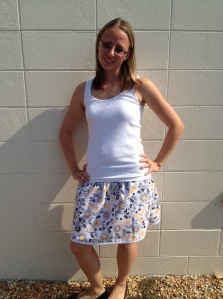
me in my shirred skirt
This is what I used for this project:
– 1 1/2 yard of the fabric of your choice
-matching thread
-shirring thread
-elastic (either 3/8″ or 1/2″…I used 1/2″ because I have a ton of it)
*OPTIONAL* bias tape (double fold) in either matching or contrasting color (I personally LOVE this skirt with bias tape so I recommend it)
MEASUREMENT MATH:
To get the width of your skirt you have to do a little math, but I promise it won’t be hard:
Measure around your hip (mine was 28 inches) x 1.75 = the width of the skirt before it is shirred (I got 49 inches)
Now divide that number by two because you are going to cut out two pieces 49 / 2 = 24.5 inches
I’m going to make a skirt that’s approximately 19 inches finished, so I’m going to cut the length of the fabric to 21 inches.
Also, if I haven’t said this enough, I don’t like to buy patterns. If it’s an easy outfit, I find it simple to eyeball a lot of it with a little extra fabric to play with if I didn’t quite get it right the first time, so here is what you do for the pockets (I’ll just label this Pattern Part A):
- Get 2 pieces of paper and tape them together so that it’s longer not wider
- put your hand on the paper up to almost your elbow with your thumb out (unless you are going for a much shorter skirt, in which you would measure to the middle of your arm)
- trace around your hand allowing a good inch or so for what will be a seam allowance – once you get to your thumb, just go across and don’t trace around your wrist (you really only need a half inch because you are using the thumb part in your side seam, but it’s okay if it’s more).

Pattern Part A
CUTTING TIME:
- Cut 2 rectangles 21″ (height of skirt) by 24.5″ (width of skirt)

my awesome fabric cut in 2 pieces 22″ by 24.5″
- 4 pocket pieces (I just folded my fabric in half and cut twice – this will give you both pocket sides)
So you have all the fabric you will need. Now it’s time to get this skirt started!
Once I’ve cut my pockets, I take the same pocket “pattern” and do a little altering to it to give me a pattern for the holes of the pockets. Take you hand on the corner of the pocket and trace your hand in a curved line. You want to make sure your hand fits in your pocket, so this is why I don’t use a set pattern. I called this Pattern Part B. Cut out that piece of your pattern.

Cut out pocket opening pattern
Now make two cuts on one side of your rectangles (this will be the front of your skirt).

front fabric piece with pocket holes cut out
Next, cut the pocket holes out of two of the pocket pieces. I make sure I have the pockets semi assembled (making sure the patterns are facing each other) so I don’t cut the wrong pieces.

Pockets with Pattern Part B cut out of front for pocket hole
Cutting is done!
SEWING TIME:
- Pin then sew the pockets together first. Make sure that the patterns are facing each other. Sew along the edge like shown in the picture. Finish with a zigzag stitch to make the pockets reinforced.
- Now pin and sew the pockets to the front of the dress. I’m using bias tape, so I’m not worrying about the edge. If you aren’t using bias tape, you need to flip the pockets and front of dress. Here are pictures of both ways:

pinned for bias tape

pinned for without bias tape
- Then I pinned the bias tape and sewed the double fold bias tape around the pocket seams.

finished pocket edge with bias tape
- Baste the pockets so that it lays flat and doesn’t come apart when you are doing next steps.
- I hemmed my dress on the bottom with bias tape for a little “decoration.” I really like how this looks, and then I don’t have to deal with a rolled hem. I did this before putting the two rectangles together. It makes it a lot easier, believe me.
- Put the two rectangles together (nice sides facing in) and sew side seams with a 1/2″ seam allowance and then zigzag stitch for reinforcement.
- Sew top of skirt for your elastic. Do this by creating a rolled hem (I’ve explained it in a previous tutorial for a pillowcase dress I made) large enough to fit your elastic band (mine is 1/2″ elastic so I created a 3/4″ space and then hem 1/4″ from the edge to create a 5/8″ hole for my elastic. Make sure to leave a 1 to 2″ hole to thread the elastic through.
- Shirred waistband (I’m excited to try this part so I’m going to go into this more in depth)
SHIRRED WAISTBAND:
I was very interested in learning how to sew a shirred waistband (or just shirr in general). I looked up a ton of tutorials, and it seems super easy. So here are the steps:
- ELASTIC THREAD! This is the main “ingredient” in shirring. You can find it in the notions section in a little package.
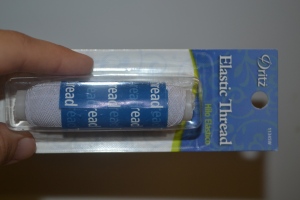
elastic thread
- Wind the bobbin. You have to do this by hand because…well, you do. I am not sure why, but everyone said to do it. I can assume one of two things. Either your machine can’t do it because the thread is much thicker than normal thread or if your machine can wind it for you, it will be too stretched out and not work when you are sewing it. So unfortunately, we do it by hand. You want to wind it without stretching it a lot because when you are sewing, it will naturally stretch.
- Keep the normal thread on the top and use the elastic on the bottom (so you will only see the elastic on one side). Make sure you sew with the the elastic on the back, though!

elastic thread wound on bobbin in machine

shirring fabric (note: elastic thread on underside of fabric with regular thread on top)
- Do not change the tension on your machine! Step away from the tension! It will be fine.
- I increased my stitch length up a bit. I think it’d be a little easier to sew when it’s around a 3.0 or so.
- Shirr in a spiral for waistbands. The nice thing about it being a skirt already is that you can keep going around and around without stopping and starting over and over again! Start at the top, just below the elastic casing. Use that edge as a guideline and keep each row about 1/4″ apart (I like to use the edge on my presser foot as my guide).
- Sew approximately 8-10 rows
- Finish sewing like normal (at a side seam preferably)

nice side of shirred fabric with 8 rows 1/4″ apart

wrong side of fabric with shirring (you can see elastic thread on this side)
Insert the elastic. Measure elastic to what your waist measurement was from above (mine was 28). Give yourself an extra inch for sewing them together. So I cut my elastic to 29″. I used a safety pin to thread my elastic through the whole in the top, above the shirred waistband, making sure that I held on to the end of the elastic so it didn’t get lost in the hole. Once you’ve gotten through the hold and are holding both ends of the elastic, sew them together. Now sew the hole shut.

elastic fed through hole with safety pin
DONE! It seemed like a lot of instructions, but it didn’t take very long to make. I have a feeling I will be making a lot of these. If not for me, than for friends or family (or my little kiddos). I had fun shirring as well! I have a feeling there will be some more shirring tutorials in my future! I hope you all found my instructions easy to understand because not only is this able to give you the freedom to pick a patterned fabric that you love, I saved about $90 making this myself!

